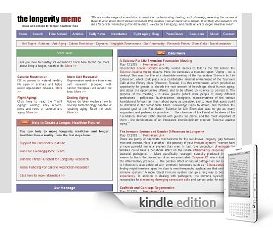Lazy Immortality
Wouldn't it be nice to wake up and find that we were all immortal? That would save a whole lot of work, uncertainty, and existential angst - and we humans are nothing if not motivated to do less work. The best of us toil endlessly in search of saving a few minutes here and a few minutes there. So it happens that there exist a range of metaphysical lines of thought - outside the bounds of theology - that suggest we humans are immortal. We should cast a suspicious eye upon any line of philosophy that would be extraordinarily convenient if true, human nature being what it is.
(An aside: the history of progress can be viewed as science wresting lines of thought from theology, one by one. It started with natural philosophy, how the mechanisms of the world actually work, detoured to capture human origins, and then moved through to cosmology and the origins of the observable universe. Ultimately, or so the semi-serious joke goes, science will capture divinity and eschatology as well. There will be no more of "the answer is God did it" save in reference to the powerful entities we will create and humorously refer to as gods when the urge takes us).
Varied non-theological metaphysical speculations on immortality largely revolve around these points:
- The existence of an extremely large universe in which replicas of you exist
- That the continuation of a replica after your own sad demise is a satisfactory form of immortality
Needless to say, I'm cutting short at the neck a number of subtleties in that two line summary, but it's about the long and short of it. If you buy in to, say, the Many Worlds Interpretation of quantum mechanics (which a great many people in the field do) and you are fine with identifying your self as a specific pattern, no matter if there are discontinuities in the existence of that pattern, then you might argue that you are immortal.
The idea that a human mind can be transferred to a new body sometimes meets the following strong objection from some who dispute neither the possibility, nor its objective manifestations as described. "Regardless of how the copying is done the end result will be a new person. If it is I who am being copied, the copy, though it may think of itself as me, is simply a self-deluded imposter. If the copying process destroys the original then I have been killed. That the copy may then have a great time exploring the universe using my name and my skills is no comfort to my mortal remains."Naturally, this point of view, which I will call the Body Identity position, makes life extension by duplication considerably less personally interesting.
I believe the objection can and should be overcome by intellectual acceptance of an alternate position I will name Pattern Identity. Body identity assumes that a person is defined by the stuff of which a human body is made. Only by maintaining continuity of body stuff can we preserve an individual person. Pattern identity, on the other hand, defines the essence of a person, say myself, as the pattern and the process going on in my head and body, not the machinery supporting that process. If the process is preserved, I am preserved. The rest is mere jelly.
This of course is all a position. The Many Worlds Interpretation is presently favored, but by no means the only decent interpretation out there. Others exist that do not imply a near-infinite universe full of near-copies of you. Similarly, one can have strong views on identity of the self depending upon personal continuity: which is to say that a copy of you is not you. If you cease to exist, your copies only grant you immortality in the same sense as people have long said that children are a form of immortality. You won't be around to enjoy it, but it might give you some personal satisfaction whilst you are still alive to have such feelings.
My own leanings are towards continuity when it comes to extending your existence. You only have one life to live, there's only one you (regardless of how many copies there may or may not be thanks to the way in which the universe works or future mind emulation technologies), and the situation is not complicated by taking place inside a simulation. This, at least, is what I think we have to assume. What you see is what you get, in other words - act as though you're not a brain in a jar being fed the perception of living in an infinite multiverse. The risk of sliding off into the space of lazy philosophical immortality is that you don't contribute to longevity science, don't work to lengthen your own life, and therefore cease to exist many years before you otherwise would have done.
Not a risk worth taking just to save a little hard work.


